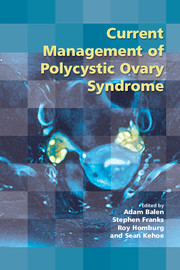Book contents
- Frontmatter
- Contents
- Participants
- Declarations of personal interest
- Preface
- 1 Overview and definitions of polycystic ovary syndrome and the polycystic ovary
- 2 Genetics and pathogenesis of polycystic ovary syndrome
- 3 Ethnic variations in the expression of polycystic ovary syndrome
- 4 Quality of life for women with polycystic ovary syndrome
- 5 Insulin resistance, the metabolic syndrome and polycystic ovary syndrome
- 6 Management of polycystic ovary syndrome through puberty and adolescence
- 7 Long-term health risks of polycystic ovary syndrome
- 8 Approaches to lifestyle management in polycystic ovary syndrome
- 9 Management of obesity in polycystic ovary syndrome, including anti-obesity drugs and bariatric surgery
- 10 Definition of hyperandrogenism
- 11 Treatment of hyperandrogenism in polycystic ovary syndrome
- 12 Choices in the treatment of anovulatory polycystic ovary syndrome
- 13 Predictors of ovarian response to ovarian stimulation: progress towards individualised treatment in ovulation induction
- 14 Surgical management of anovulatory infertility in polycystic ovary syndrome
- 15 The role of insulin-sensitising drugs in the treatment of polycystic ovary syndrome
- 16 The role of in vitro maturation of oocytes for anovulatory polycystic ovary syndrome
- 17 Acupuncture and/or herbal therapy as an alternative or complement for relief of polycystic ovary syndrome-related symptoms
- 18 Consensus views arising from the 59th Study Group: Current Management of Polycystic Ovary Syndrome
- Index
12 - Choices in the treatment of anovulatory polycystic ovary syndrome
Published online by Cambridge University Press: 05 July 2014
- Frontmatter
- Contents
- Participants
- Declarations of personal interest
- Preface
- 1 Overview and definitions of polycystic ovary syndrome and the polycystic ovary
- 2 Genetics and pathogenesis of polycystic ovary syndrome
- 3 Ethnic variations in the expression of polycystic ovary syndrome
- 4 Quality of life for women with polycystic ovary syndrome
- 5 Insulin resistance, the metabolic syndrome and polycystic ovary syndrome
- 6 Management of polycystic ovary syndrome through puberty and adolescence
- 7 Long-term health risks of polycystic ovary syndrome
- 8 Approaches to lifestyle management in polycystic ovary syndrome
- 9 Management of obesity in polycystic ovary syndrome, including anti-obesity drugs and bariatric surgery
- 10 Definition of hyperandrogenism
- 11 Treatment of hyperandrogenism in polycystic ovary syndrome
- 12 Choices in the treatment of anovulatory polycystic ovary syndrome
- 13 Predictors of ovarian response to ovarian stimulation: progress towards individualised treatment in ovulation induction
- 14 Surgical management of anovulatory infertility in polycystic ovary syndrome
- 15 The role of insulin-sensitising drugs in the treatment of polycystic ovary syndrome
- 16 The role of in vitro maturation of oocytes for anovulatory polycystic ovary syndrome
- 17 Acupuncture and/or herbal therapy as an alternative or complement for relief of polycystic ovary syndrome-related symptoms
- 18 Consensus views arising from the 59th Study Group: Current Management of Polycystic Ovary Syndrome
- Index
Summary
Introduction
Polycystic ovary syndrome (PCOS) is present in approximately 75% of women with infertility due to anovulation and it is frequently diagnosed for the first time in the fertility clinic. The majority of women with anovulation or oligo-ovulation due to PCOS have clinical and/or biochemical evidence of hyperandrogenism. Almost all these women will have a typical ultrasonic appearance of the ovaries.
The exact mechanism causing anovulation associated with PCOS is not known and the excess of small antral follicles, hyperandrogenaemia, hyperinsulinaemia and dysfunctional feedback mechanisms have all been implicated. There are, however, a number of strategies to restore ovulation, most of them reliant on increasing follicle-stimulating hormone (FSH) concentrations, either endogenously or exogenously, or reducing insulin levels. These include medical therapies such as clomifene citrate, aromatase inhibitors, metformin and low-dose gonadotrophin therapy and surgical treatment by laparoscopic ovarian diathermy. This chapter describes treatment with clomifene, aromatase inhibitors and gonadotrophins in detail, but metformin only in brief as it is covered in full in Chapter 15. Laparoscopic ovarian diathermy is discussed in Chapter 14.
Weight loss
Whereas obesity expresses and exaggerates the signs and symptoms of insulin resistance, loss of weight can reverse this process by improving ovarian function and the associated hormonal abnormalities and may alone induce ovulation and pregnancy. Loss of weight induces a reduction of insulin and androgen concentrations and an increase in sex hormone-binding globulin concentrations.
Keywords
- Type
- Chapter
- Information
- Current Management of Polycystic Ovary Syndrome , pp. 143 - 152Publisher: Cambridge University PressPrint publication year: 2010
- 1
- Cited by



